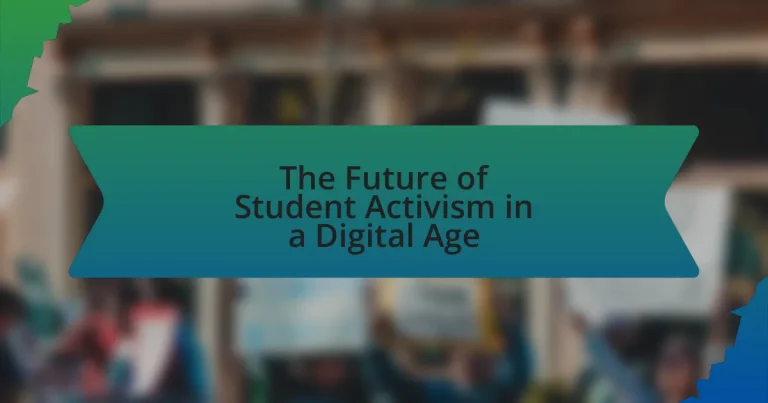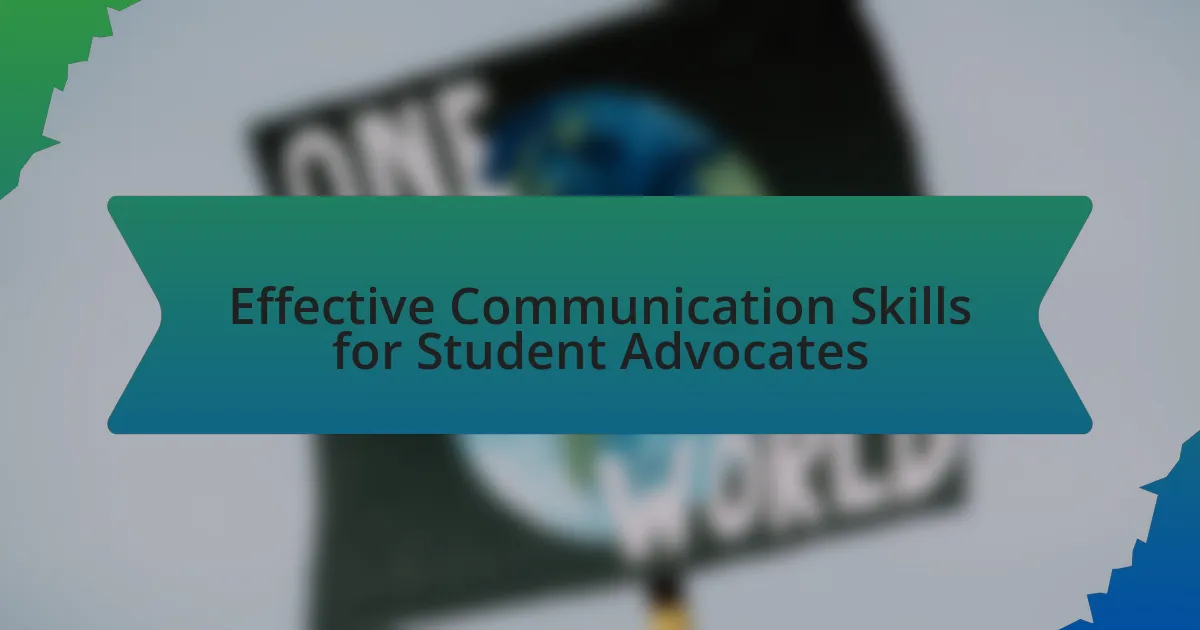The article examines the future of student activism in the context of a digital age, highlighting how technology, particularly social media, has transformed the landscape of activism. It discusses the historical influence of technology on student movements, key advancements that have shaped current practices, and the challenges activists face, such as misinformation and privacy concerns. Additionally, the article explores opportunities presented by digital tools for organization and mobilization, the importance of collaboration, and strategies for effective engagement. It concludes by emphasizing the implications of digital activism for future generations and the evolving nature of student-led movements.
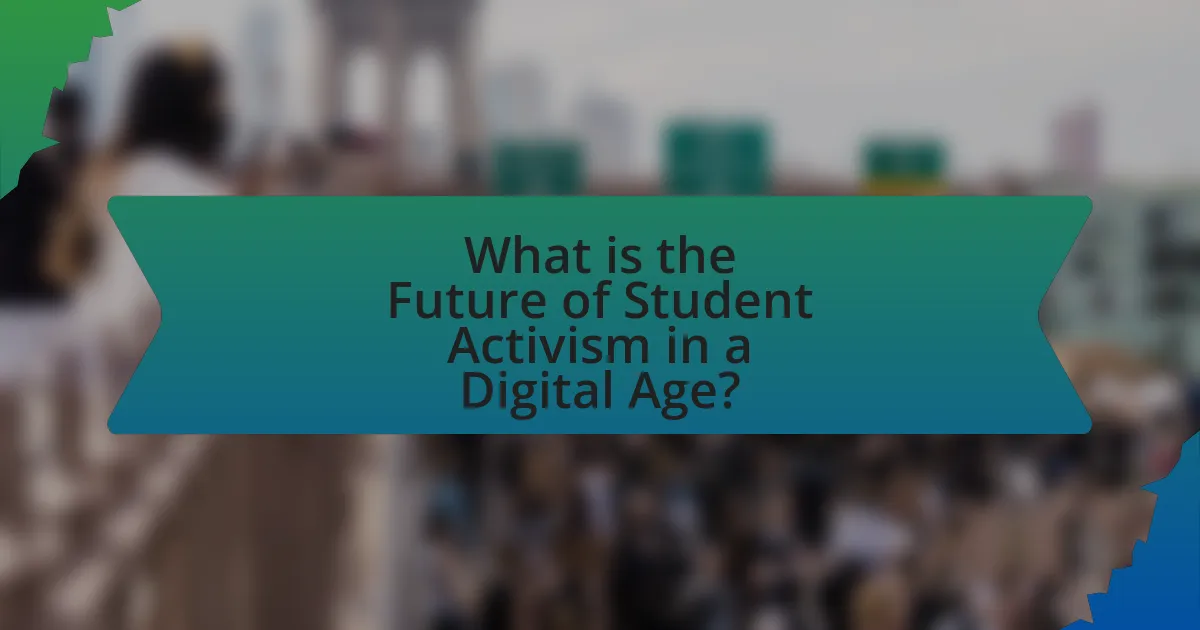
What is the Future of Student Activism in a Digital Age?
The future of student activism in a digital age is characterized by increased connectivity and the ability to mobilize quickly through social media platforms. Digital tools enable students to organize protests, share information, and raise awareness on issues such as climate change, racial justice, and educational reform. For instance, the global climate strikes led by students in 2019 demonstrated how digital communication can unite young activists across different countries, resulting in millions participating simultaneously. This trend indicates that student activism will likely continue to evolve, leveraging technology to amplify voices and foster collaboration on a global scale.
How has technology influenced student activism historically?
Technology has significantly influenced student activism historically by enhancing communication, mobilization, and organization among students. For instance, during the 1960s, the advent of photocopiers allowed activists to disseminate information rapidly, facilitating the spread of ideas and organizing protests, such as those against the Vietnam War. In the 1980s, the emergence of personal computers and early internet platforms enabled students to connect across campuses and share resources, leading to coordinated efforts in movements like the anti-apartheid struggle. More recently, social media platforms have transformed student activism by providing real-time communication and broader outreach, exemplified by movements like #BlackLivesMatter, which mobilized students nationwide through platforms like Twitter and Facebook. These technological advancements have consistently empowered students to amplify their voices and effect change.
What are the key technological advancements that have shaped student activism?
Key technological advancements that have shaped student activism include social media platforms, mobile communication, and online petitioning tools. Social media platforms like Twitter and Facebook have enabled rapid dissemination of information, allowing students to organize protests and share their messages widely. Mobile communication, particularly through smartphones, has facilitated real-time coordination and mobilization of activists during events. Online petitioning tools, such as Change.org, have empowered students to gather support for their causes quickly, demonstrating the effectiveness of digital advocacy. These advancements have transformed traditional activism into a more dynamic and accessible form, significantly increasing student engagement and participation in social issues.
How have social media platforms changed the landscape of student activism?
Social media platforms have significantly transformed student activism by providing instant communication, broader reach, and enhanced organization capabilities. These platforms enable students to mobilize quickly around issues, share information widely, and connect with like-minded individuals across geographical boundaries. For instance, the #BlackLivesMatter movement gained momentum through Twitter and Instagram, allowing students to organize protests and share resources effectively. Additionally, a study by the Pew Research Center found that 69% of teens use social media to engage with social issues, highlighting its role in shaping activism among younger generations. This shift has made activism more accessible and visible, allowing student voices to be amplified in ways that were not possible before.
What challenges do student activists face in the digital age?
Student activists face significant challenges in the digital age, including misinformation, surveillance, and digital divide issues. Misinformation can undermine their campaigns, as false narratives spread rapidly online, complicating efforts to mobilize support. Surveillance poses a risk to their safety and privacy, as governments and institutions may monitor online activities, leading to potential repercussions for activists. Additionally, the digital divide creates disparities in access to technology and the internet, limiting participation for students from marginalized backgrounds. These challenges highlight the complexities of organizing and advocating for change in a highly connected yet often hostile digital environment.
How does misinformation impact student activism efforts?
Misinformation significantly undermines student activism efforts by distorting facts and creating confusion among activists and their supporters. When students encounter false information, it can lead to misguided actions, erode trust in credible sources, and polarize communities, ultimately hindering collective efforts for social change. For instance, a study by the Pew Research Center found that 64% of Americans believe misinformation has a major impact on public opinion, which directly affects how student-led movements are perceived and supported. This distortion can result in decreased participation in protests or campaigns, as students may feel uncertain about the issues at hand or the legitimacy of their cause.
What are the risks of online activism for students?
The risks of online activism for students include potential backlash from authorities, exposure to cyberbullying, and privacy violations. Students engaging in online activism may face disciplinary actions from educational institutions or legal repercussions from government entities, as seen in cases where protests or online campaigns challenge established policies. Additionally, the anonymity of the internet can lead to targeted harassment, with studies indicating that 40% of young activists report experiencing online threats. Privacy concerns arise when personal information is shared or leaked, which can lead to doxxing, where individuals’ private details are exposed publicly. These risks highlight the need for students to navigate online activism with caution and awareness.
What opportunities does the digital age present for student activism?
The digital age presents significant opportunities for student activism by enabling rapid communication, widespread information dissemination, and global connectivity. Students can leverage social media platforms to organize events, share their causes, and mobilize support quickly, as evidenced by movements like #BlackLivesMatter, which gained traction through online platforms. Additionally, digital tools allow for the creation of petitions and fundraising campaigns, facilitating grassroots efforts that can reach a larger audience than traditional methods. The accessibility of information through the internet empowers students to educate themselves and others about social issues, fostering informed activism.
How can digital tools enhance organization and mobilization among students?
Digital tools enhance organization and mobilization among students by providing platforms for communication, collaboration, and information sharing. These tools, such as social media, messaging apps, and project management software, facilitate real-time interaction and coordination, allowing students to quickly disseminate information about events, campaigns, and initiatives. For instance, a study by the Pew Research Center found that 88% of young adults use social media, which serves as a powerful medium for rallying support and organizing protests or meetings. Additionally, digital tools enable students to create and share petitions, organize fundraising efforts, and coordinate logistics for events, thereby increasing participation and engagement in activism.
What role do online communities play in supporting student activism?
Online communities play a crucial role in supporting student activism by providing platforms for organization, mobilization, and information sharing. These digital spaces enable students to connect with like-minded individuals, facilitating the exchange of ideas and strategies for activism. For instance, social media platforms like Twitter and Facebook have been instrumental in organizing protests and campaigns, as evidenced by movements such as the March for Our Lives, which gained momentum through online engagement. Additionally, online communities offer resources and support networks that empower students to advocate for social change, enhancing their ability to influence public discourse and policy.
How can student activists effectively utilize digital platforms?
Student activists can effectively utilize digital platforms by leveraging social media for awareness, mobilization, and community building. Social media platforms like Twitter, Instagram, and Facebook allow activists to reach a broad audience quickly, share information, and organize events. For instance, the #BlackLivesMatter movement gained significant traction through Twitter, where activists shared real-time updates and mobilized protests, demonstrating the power of digital platforms in amplifying voices and fostering solidarity. Additionally, using tools like online petitions and crowdfunding platforms can help student activists gather support and resources for their causes, as seen with the success of Change.org petitions that have led to tangible policy changes.
What strategies can be employed to engage a wider audience online?
To engage a wider audience online, leveraging social media platforms is essential, as they provide access to diverse demographics. Utilizing targeted advertising on platforms like Facebook and Instagram can increase visibility among specific groups, while creating shareable content encourages organic reach. For instance, a study by Pew Research Center indicates that 69% of adults use Facebook, making it a prime platform for outreach. Additionally, incorporating interactive elements such as polls, live Q&A sessions, and user-generated content fosters community involvement and enhances engagement. These strategies collectively create a more inclusive online environment, attracting a broader audience to student activism initiatives.
How can student activists measure the impact of their digital campaigns?
Student activists can measure the impact of their digital campaigns by analyzing engagement metrics, such as likes, shares, comments, and follower growth across social media platforms. These metrics provide quantitative data that reflects the reach and resonance of their messages. For instance, a study by the Pew Research Center found that 69% of adults in the U.S. use social media, indicating a significant potential audience for digital campaigns. Additionally, activists can utilize tools like Google Analytics to track website traffic and conversion rates, which helps assess how many users took action after engaging with the campaign. Surveys and feedback forms can also be employed to gather qualitative data on public perception and awareness, further enhancing the understanding of campaign effectiveness.
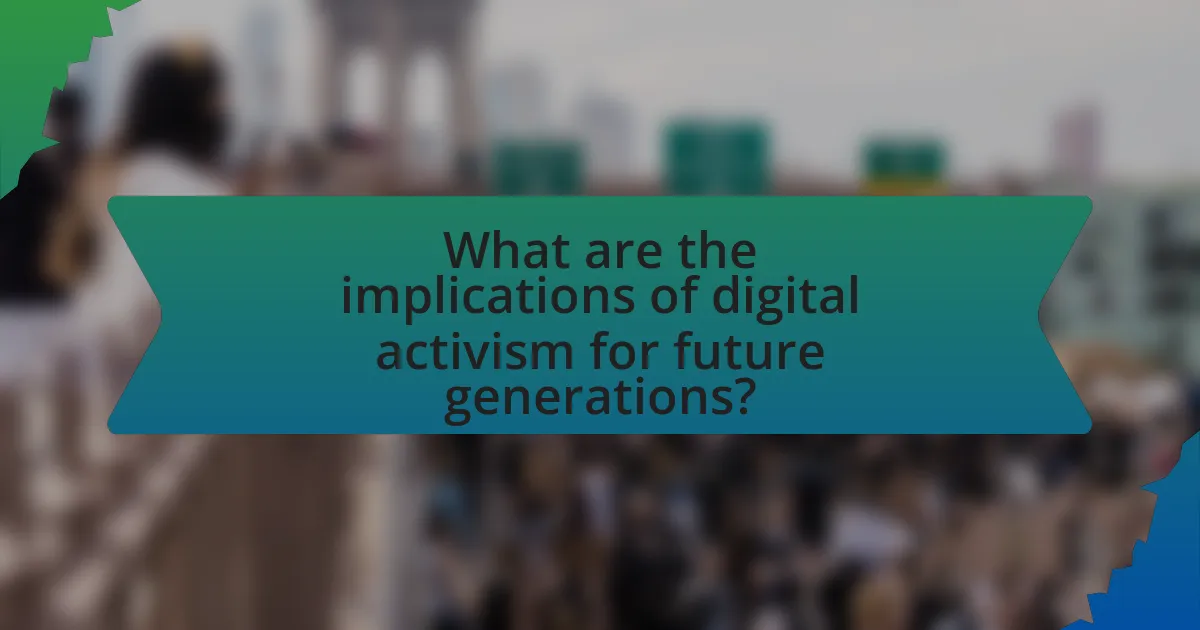
What are the implications of digital activism for future generations?
Digital activism will significantly shape future generations by fostering greater political engagement and social awareness. As young people increasingly utilize digital platforms to mobilize and advocate for change, they develop skills in organization, communication, and critical thinking. Research indicates that 70% of youth believe social media empowers them to influence political issues, highlighting its role in shaping civic participation. Furthermore, digital activism cultivates a sense of global interconnectedness, as movements can transcend geographical boundaries, allowing future generations to collaborate on a larger scale. This interconnectedness is evidenced by movements like #BlackLivesMatter and #FridaysForFuture, which have mobilized millions worldwide, demonstrating the potential for collective action in addressing pressing social issues.
How might digital activism evolve in the coming years?
Digital activism is likely to evolve through increased integration of artificial intelligence and data analytics, enhancing the ability to mobilize and engage supporters effectively. As technology advances, platforms will provide more sophisticated tools for organizing campaigns, analyzing social media trends, and targeting specific demographics. For instance, the use of AI-driven algorithms can help identify key influencers and optimize messaging strategies, leading to more impactful outreach. Additionally, the rise of decentralized platforms and blockchain technology may empower activists by ensuring greater security and transparency in their efforts, as seen in recent movements that prioritize privacy and data protection. This evolution reflects a broader trend of leveraging technology to amplify voices and drive social change in a rapidly digitizing world.
What emerging technologies could further influence student activism?
Emerging technologies that could further influence student activism include artificial intelligence, blockchain, and augmented reality. Artificial intelligence can analyze social media trends and sentiments, enabling activists to tailor their messages effectively and mobilize support quickly. Blockchain technology offers secure and transparent platforms for fundraising and organizing, ensuring that donations are tracked and used appropriately, which can enhance trust among supporters. Augmented reality can create immersive experiences that raise awareness about social issues, making activism more engaging and impactful. These technologies collectively empower students to organize, communicate, and advocate for change more efficiently and effectively.
How can future student activists prepare for changes in the digital landscape?
Future student activists can prepare for changes in the digital landscape by developing digital literacy skills and understanding the evolving nature of online platforms. Digital literacy enables activists to effectively navigate social media, utilize data privacy tools, and engage with diverse online communities. Research indicates that 90% of young people use social media, making it a crucial space for activism (Pew Research Center, 2021). Additionally, staying informed about digital security practices is essential, as cyber threats can undermine activist efforts. By participating in workshops and training sessions focused on these skills, future activists can enhance their ability to mobilize support and advocate for their causes in a rapidly changing digital environment.
What lessons can current student activists learn from past movements?
Current student activists can learn the importance of coalition-building and strategic communication from past movements. Historical examples, such as the Civil Rights Movement, demonstrate that diverse groups uniting for a common cause can amplify their impact; for instance, the collaboration between various civil rights organizations led to significant legislative changes like the Civil Rights Act of 1964. Additionally, the use of effective messaging and media, as seen in the anti-Vietnam War protests, highlights the necessity of adapting communication strategies to reach broader audiences, particularly in a digital age where social media can rapidly disseminate information and mobilize support.
How have previous student movements adapted to technological changes?
Previous student movements have adapted to technological changes by leveraging digital platforms for organization, communication, and mobilization. For instance, during the Arab Spring, student activists utilized social media to coordinate protests and disseminate information rapidly, which significantly increased their reach and impact. Additionally, movements like Occupy Wall Street employed live-streaming and social media to document events in real-time, fostering global solidarity and support. These adaptations demonstrate how technology has transformed traditional activism into a more dynamic and interconnected process, allowing for greater participation and engagement across diverse demographics.
What successful strategies from past movements can be applied today?
Successful strategies from past movements that can be applied today include grassroots organizing, coalition-building, and leveraging digital platforms for outreach and mobilization. Grassroots organizing, exemplified by the Civil Rights Movement, emphasizes local engagement and community involvement, which can empower students to address specific issues in their schools and communities. Coalition-building, as seen in the anti-apartheid movement, fosters collaboration among diverse groups, enhancing the impact of student activism by uniting various stakeholders around common goals. Additionally, leveraging digital platforms, a strategy effectively utilized during the Arab Spring, allows for rapid dissemination of information, mobilization of supporters, and global awareness, making it easier for student activists to connect and coordinate efforts across geographical boundaries. These strategies are validated by historical successes, demonstrating their relevance and effectiveness in contemporary activism.
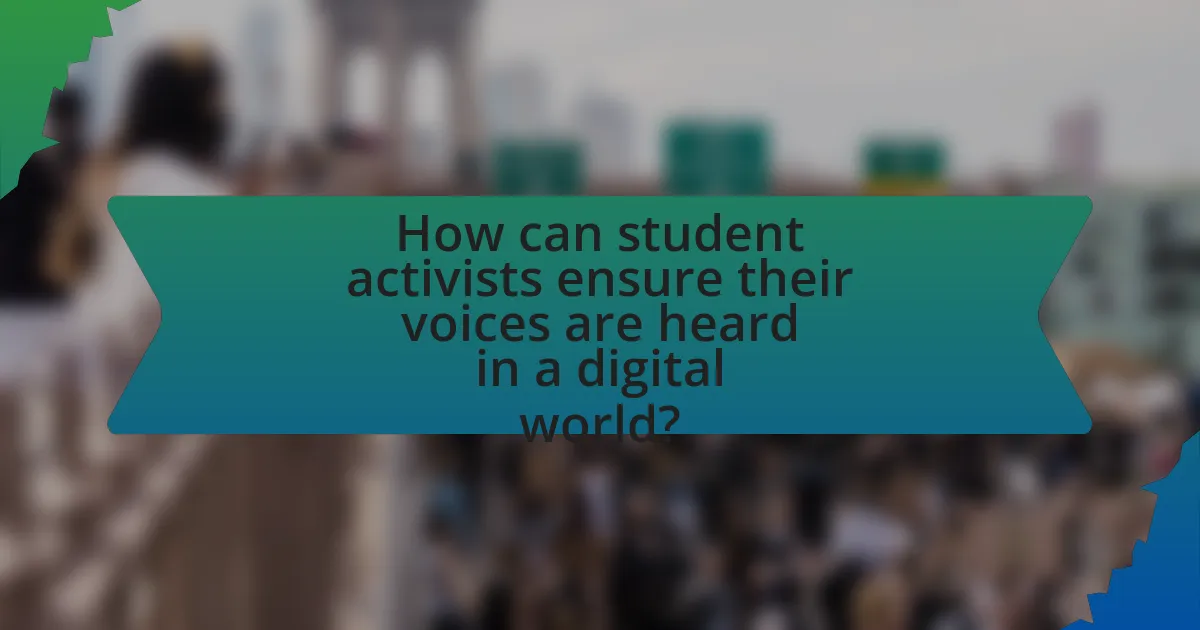
How can student activists ensure their voices are heard in a digital world?
Student activists can ensure their voices are heard in a digital world by leveraging social media platforms to amplify their messages and engage with a broader audience. Research indicates that 79% of young people use social media, making it a powerful tool for mobilization and awareness (Pew Research Center, 2021). By creating compelling content, utilizing hashtags, and collaborating with influencers, student activists can increase visibility and foster community support. Additionally, organizing online petitions and virtual events can facilitate participation and drive action, further solidifying their presence in the digital landscape.
What best practices should student activists follow in their digital campaigns?
Student activists should prioritize clear messaging, audience engagement, and data privacy in their digital campaigns. Clear messaging ensures that the campaign’s goals and calls to action are easily understood, which is crucial for mobilizing support. Engaging with the audience through interactive content, such as polls and Q&A sessions, fosters community involvement and strengthens the campaign’s impact. Additionally, maintaining data privacy protects the identities and information of supporters, which is essential in an era of increasing surveillance and data breaches. According to a study by the Pew Research Center, 70% of social media users are concerned about their privacy, highlighting the importance of this practice in building trust and credibility.
How can storytelling enhance the effectiveness of student activism online?
Storytelling enhances the effectiveness of student activism online by creating emotional connections that engage audiences and motivate action. When students share personal narratives related to their causes, they humanize issues, making them relatable and compelling. Research indicates that emotionally charged stories can increase empathy and drive engagement; for instance, a study published in the journal “Science” found that narratives can significantly influence attitudes and behaviors by fostering a sense of connection and urgency. By utilizing storytelling, student activists can effectively mobilize support, raise awareness, and inspire collective action in the digital landscape.
What role does collaboration play in successful digital activism?
Collaboration is essential for successful digital activism as it amplifies voices, increases resource sharing, and fosters a sense of community among activists. When individuals and organizations work together, they can combine their strengths, such as diverse skills, networks, and perspectives, which enhances the overall impact of their campaigns. For instance, the #BlackLivesMatter movement effectively utilized collaboration across various social media platforms, uniting activists globally to raise awareness and mobilize support for racial justice. This collective effort not only broadened the reach of their message but also facilitated coordinated actions, demonstrating that collaborative strategies can lead to significant social change.
What resources are available for student activists in the digital age?
Student activists in the digital age have access to various resources that enhance their ability to organize, communicate, and advocate for change. These resources include social media platforms like Twitter and Instagram, which facilitate rapid information sharing and mobilization of supporters. Additionally, online tools such as Change.org and Avaaz allow activists to create petitions and campaigns that can reach a global audience. Research from the Pew Research Center indicates that 69% of adults in the U.S. use social media, highlighting its significance as a tool for activism. Furthermore, digital communication tools like Slack and Discord enable collaboration among activists, fostering community and strategic planning. These resources collectively empower student activists to effectively engage in social and political issues in a connected world.
Which organizations provide support and training for digital activism?
Organizations that provide support and training for digital activism include the Electronic Frontier Foundation (EFF), which focuses on defending civil liberties in the digital world, and the Center for Media Justice, which advocates for media rights and social justice. Additionally, the Tactical Technology Collective offers resources and training for activists on digital security and privacy. These organizations are recognized for their contributions to empowering individuals and groups in the realm of digital activism, providing essential tools, resources, and training to navigate the complexities of online advocacy effectively.
How can students access tools and platforms for effective activism?
Students can access tools and platforms for effective activism through online resources, social media, and educational institutions. Online platforms such as Change.org and Avaaz provide avenues for petitioning and mobilizing support for various causes. Social media networks like Twitter, Instagram, and Facebook enable students to share information, organize events, and connect with like-minded individuals. Educational institutions often offer workshops, training sessions, and access to digital tools that enhance students’ activism skills. According to a 2021 study by the Pew Research Center, 70% of young adults reported using social media for political engagement, highlighting its significance in modern activism.
What are the key takeaways for aspiring student activists in a digital age?
Aspiring student activists in a digital age should prioritize building a strong online presence and utilizing social media effectively to mobilize support and raise awareness. Engaging with diverse platforms allows activists to reach a broader audience, as studies show that 69% of adults in the U.S. use social media, making it a powerful tool for advocacy. Additionally, understanding digital security and privacy is crucial, as activists face risks of surveillance and harassment; for instance, the Electronic Frontier Foundation emphasizes the importance of protecting personal information online. Lastly, collaboration with established organizations can amplify efforts, as partnerships often lead to increased resources and visibility, evidenced by successful campaigns like the March for Our Lives, which leveraged both grassroots organizing and digital outreach.
